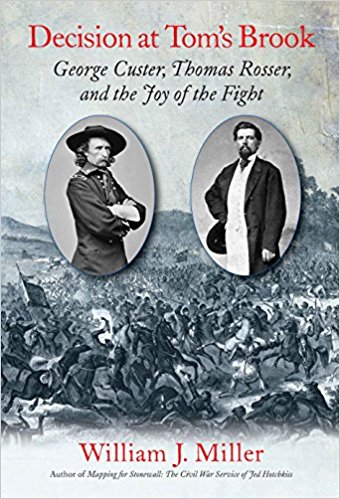William J. Miller
Savas Beatie, 2016, 268 pp., $29.95
ISBN: 978-1-61121-308-9
Image courtesy of amazon.com
George Custer has gone down in history as one of the great names of our nation, but what he is most well known for is the failure he faced at Little Big Horn. But as you look at the life of Custer, you begin to see other things in his military career which he should be more well known for but is forgotten. Custer fought at East Cavalry Field in the Battle of Gettysburg; he graduated at the bottom of his class at West Point for interesting reasons. All of these get forgotten if you look at that failure. Thankfully, William J. Miller’s work, Decision at Tom’s Brook, brings about more information about this fascinating character in history along with a few others whom we should remember as well.
William J. Miller is a teacher, writer, and preservationist; he is a former editor of Civil War Magazine and has authored other works as well. Mapping for Stonewall: The Civil War Service of Jed Hotchkiss, won the Fletcher Pratt Award for best Civil War nonfiction in 1993. He also wrote Great Maps of the Civil War: Pivotal Battles and Campaigns. Decision at Tom’s Brook is his ninth book about the Civil War.
The Battle of Tom’s Brook is one which has been covered in the past, but not to the extent which Miller has taken in my experience. It is books like these which make my reading interesting. I knew next to nothing about this battle going into the narrative and to learn about this disaster, according to a Confederate soldier in his account, was wonderful. I extensively mentioned Custer in the introduction but there is another personality which Miller highlights: Thomas L. Rosser. Both attended West Point before the war but when it broke out, as so many heartbreaking Civil War stories follow, they split, with Rosser serving in the Confederacy. Off the bat, Miller not only makes his narrative about the Battle of Tom’s Brook, but he highlights the relationship between the two and shows that they had not met in battle until this moment. There were moments within the book which left me enthralled; some of them were even written with the gravitas of tragedy. It is that kind of narrative which keeps my interest alive in the Civil War and I’m sure that other readers would agree. Behind the “friend against friend” narrative is an amazing account of the battle and the details of the combat which was had at Tom’s Brook. It is not one to be missed.
I highly recommend this book to anyone interested in learning more about the Battle of Tom’s Brook. There is also a high recommendation to anyone who is fascinated with the “brother against brother,” or “friend against friend” ideals which the Civil War brought with it. The narrative is exquisite and is aided by wonderfully drawn maps. The research which went into this work is nothing short of a labor of love and Miller should be praised for what he brought to the forefront. Highly recommended!

 RSS Feed
RSS Feed
